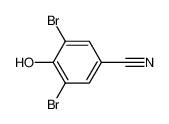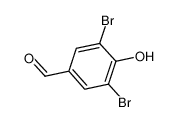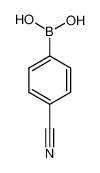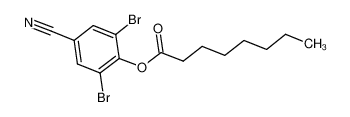1.Identification
1.1 GHS Product identifier
| Product name | 3,5-dibromo-4-hydroxybenzonitrile |
|---|
1.2 Other means of identification
| Product number | - |
|---|---|
| Other names | Bromoxynil |
1.3 Recommended use of the chemical and restrictions on use
| Identified uses | For industry use only. |
|---|---|
| Uses advised against | no data available |
1.4 Supplier's details
| Company | MOLBASE (Shanghai) Biotechnology Co., Ltd. |
|---|---|
| Address | Floor 4 & 5, Building 12, No. 1001 North Qinzhou Road, Xuhui District, Shanghai, China |
| Telephone | +86(21)64956998 |
| Fax | +86(21)54365166 |
1.5 Emergency phone number
| Emergency phone number | +86-400-6021-666 |
|---|---|
| Service hours | Monday to Friday, 9am-5pm (Standard time zone: UTC/GMT +8 hours). |
2.Hazard identification
2.1 Classification of the substance or mixture
Acute toxicity - Oral, Category 3
Skin sensitization, Category 1
Acute toxicity - Inhalation, Category 2
Hazardous to the aquatic environment, short-term (Acute) - Category Acute 1
Hazardous to the aquatic environment, long-term (Chronic) - Category Chronic 1
Reproductive toxicity, Category 2
2.2 GHS label elements, including precautionary statements
| Pictogram(s) |    |
|---|---|
| Signal word | Danger |
| Hazard statement(s) | H301 Toxic if swallowed H317 May cause an allergic skin reaction H330 Fatal if inhaled H410 Very toxic to aquatic life with long lasting effects H361d |
| Precautionary statement(s) | |
| Prevention | P264 Wash ... thoroughly after handling. P270 Do not eat, drink or smoke when using this product. P261 Avoid breathing dust/fume/gas/mist/vapours/spray. P272 Contaminated work clothing should not be allowed out of the workplace. P280 Wear protective gloves/protective clothing/eye protection/face protection. P260 Do not breathe dust/fume/gas/mist/vapours/spray. P271 Use only outdoors or in a well-ventilated area. P284 [In case of inadequate ventilation] wear respiratory protection. P273 Avoid release to the environment. P201 Obtain special instructions before use. P202 Do not handle until all safety precautions have been read and understood. |
| Response | P301+P310 IF SWALLOWED: Immediately call a POISON CENTER/doctor/… P321 Specific treatment (see ... on this label). P330 Rinse mouth. P302+P352 IF ON SKIN: Wash with plenty of water/... P333+P313 If skin irritation or rash occurs: Get medical advice/attention. P362+P364 Take off contaminated clothing and wash it before reuse. P304+P340 IF INHALED: Remove person to fresh air and keep comfortable for breathing. P310 Immediately call a POISON CENTER/doctor/… P320 Specific treatment is urgent (see ... on this label). P391 Collect spillage. P308+P313 IF exposed or concerned: Get medical advice/ attention. |
| Storage | P405 Store locked up. P403+P233 Store in a well-ventilated place. Keep container tightly closed. |
| Disposal | P501 Dispose of contents/container to ... |
2.3 Other hazards which do not result in classification
none
3.Composition/information on ingredients
3.1 Substances
| Chemical name | Common names and synonyms | CAS number | EC number | Concentration |
|---|---|---|---|---|
| 3,5-dibromo-4-hydroxybenzonitrile | 3,5-dibromo-4-hydroxybenzonitrile | 1689-84-5 | none | 100% |
4.First-aid measures
4.1 Description of necessary first-aid measures
General advice
Consult a physician. Show this safety data sheet to the doctor in attendance.
If inhaled
If breathed in, move person into fresh air. If not breathing, give artificial respiration. Consult a physician.
In case of skin contact
Wash off with soap and plenty of water. Consult a physician.
In case of eye contact
Rinse thoroughly with plenty of water for at least 15 minutes and consult a physician.
If swallowed
Never give anything by mouth to an unconscious person. Rinse mouth with water. Consult a physician.
4.2 Most important symptoms/effects, acute and delayed
Excerpt from ERG Guide 154 [Substances - Toxic and/or Corrosive (Non-Combustible)]: TOXIC; inhalation, ingestion or skin contact with material may cause severe injury or death. Contact with molten substance may cause severe burns to skin and eyes. Avoid any skin contact. Effects of contact or inhalation may be delayed. Fire may produce irritating, corrosive and/or toxic gases. Runoff from fire control or dilution water may be corrosive and/or toxic and cause pollution. (ERG, 2016)
4.3 Indication of immediate medical attention and special treatment needed, if necessary
/SRP:/ Immediate first aid: Ensure that adequate decontamination has been carried out. If patient is not breathing, start artificial respiration, preferably with a demand valve resuscitator, bag-valve-mask device, or pocket mask, as trained. Perform CPR if necessary. Immediately flush contaminated eyes with gently flowing water. Do not induce vomiting. If vomiting occurs, lean patient forward or place on the left side (head-down position, if possible) to maintain an open airway and prevent aspiration. Keep patient quiet and maintain normal body temperature. Obtain medical attention. /Poisons A and B/
5.Fire-fighting measures
5.1 Extinguishing media
Suitable extinguishing media
Extinguishing Media: Carbon dioxide or dry chemical for small fires. Water spray or alcohol-type foam for large fires.
5.2 Specific hazards arising from the chemical
Excerpt from ERG Guide 154 [Substances - Toxic and/or Corrosive (Non-Combustible)]: Non-combustible, substance itself does not burn but may decompose upon heating to produce corrosive and/or toxic fumes. Some are oxidizers and may ignite combustibles (wood, paper, oil, clothing, etc.). Contact with metals may evolve flammable hydrogen gas. Containers may explode when heated. For electric vehicles or equipment, ERG Guide 147 (lithium ion batteries) or ERG Guide 138 (sodium batteries) should also be consulted. (ERG, 2016)
5.3 Special protective actions for fire-fighters
Wear self-contained breathing apparatus for firefighting if necessary.
6.Accidental release measures
6.1 Personal precautions, protective equipment and emergency procedures
Use personal protective equipment. Avoid dust formation. Avoid breathing vapours, mist or gas. Ensure adequate ventilation. Evacuate personnel to safe areas. Avoid breathing dust. For personal protection see section 8.
6.2 Environmental precautions
Prevent further leakage or spillage if safe to do so. Do not let product enter drains. Discharge into the environment must be avoided.
6.3 Methods and materials for containment and cleaning up
Do not contaminate /receiving/ water when disposing of equipment washwaters. /Moxy 2E/
7.Handling and storage
7.1 Precautions for safe handling
Avoid contact with skin and eyes. Avoid formation of dust and aerosols. Avoid exposure - obtain special instructions before use.Provide appropriate exhaust ventilation at places where dust is formed. For precautions see section 2.2.
7.2 Conditions for safe storage, including any incompatibilities
Store at temperatures above 3 deg F. If allowed to freeze, remix before using. Do not contaminate water, food, or feed by storage ... of this chemical.
8.Exposure controls/personal protection
8.1 Control parameters
Occupational Exposure limit values
no data available
Biological limit values
no data available
8.2 Appropriate engineering controls
Handle in accordance with good industrial hygiene and safety practice. Wash hands before breaks and at the end of workday.
8.3 Individual protection measures, such as personal protective equipment (PPE)
Eye/face protection
Safety glasses with side-shields conforming to EN166. Use equipment for eye protection tested and approved under appropriate government standards such as NIOSH (US) or EN 166(EU).
Skin protection
Wear impervious clothing. The type of protective equipment must be selected according to the concentration and amount of the dangerous substance at the specific workplace. Handle with gloves. Gloves must be inspected prior to use. Use proper glove removal technique(without touching glove's outer surface) to avoid skin contact with this product. Dispose of contaminated gloves after use in accordance with applicable laws and good laboratory practices. Wash and dry hands. The selected protective gloves have to satisfy the specifications of EU Directive 89/686/EEC and the standard EN 374 derived from it.
Respiratory protection
Wear dust mask when handling large quantities.
Thermal hazards
no data available
9.Physical and chemical properties
| Physical state | Off-white to salmon crystalline powder |
|---|---|
| Colour | WHITE CRYSTALLINE SOLID |
| Odour | ODORLESS WHEN PURE |
| Melting point/ freezing point | 188-192ºC |
| Boiling point or initial boiling point and boiling range | 265.6ºC at 760 mmHg |
| Flammability | no data available |
| Lower and upper explosion limit / flammability limit | no data available |
| Flash point | 114.4ºC |
| Auto-ignition temperature | no data available |
| Decomposition temperature | no data available |
| pH | no data available |
| Kinematic viscosity | no data available |
| Solubility | IN WATER 130 PPM (0.013%) WT/VOL @ 20-25 DEG C; IN ETHANOL 7% WT/VOL @ 20-25 DEG C; IN LIGHT PETROLEUM & XYLENE 1-2% WT/VOL @ 20-25 DEG C |
| Partition coefficient n-octanol/water (log value) | log Kow = 2.70 |
| Vapour pressure | 0.00552mmHg at 25°C |
| Density and/or relative density | 2.24 g/cm3 |
| Relative vapour density | no data available |
| Particle characteristics | no data available |
10.Stability and reactivity
10.1 Reactivity
no data available
10.2 Chemical stability
NO DETERIORATION IN OVER 2 YEARS STORAGE TIME
10.3 Possibility of hazardous reactions
BROMOXYNIL is a weak acid.
10.4 Conditions to avoid
no data available
10.5 Incompatible materials
no data available
10.6 Hazardous decomposition products
When heated to decomp it emits highly toxic fumes of /nitrogen oxides, hydrogen cyanide and hydrogen bromide/.
11.Toxicological information
Acute toxicity
- Oral: LD50 Mouse oral 110 mg/kg
- Inhalation: no data available
- Dermal: LD50 Rat percutaneous >2000 mg/kg
Skin corrosion/irritation
no data available
Serious eye damage/irritation
no data available
Respiratory or skin sensitization
no data available
Germ cell mutagenicity
no data available
Carcinogenicity
Cancer Classification: Group C Possible Human Carcinogen
Reproductive toxicity
no data available
STOT-single exposure
no data available
STOT-repeated exposure
no data available
Aspiration hazard
no data available
12.Ecological information
12.1 Toxicity
- Toxicity to fish: LC50; Species: Lepomis macrochirus (Bluegill); Conditions: freshwater, static; Concentration: 23000 ug/L for 96 hr (95% confidence interval: 18000-30000 ug/L) /21.5% purity formulation
- Toxicity to daphnia and other aquatic invertebrates: EC50; Species: Daphnia magna (Water Flea) age <24 hr; Conditions: freshwater, static; Concentration: 19220 ug/L for 48 hr (95% confidence interval: 13000-36000 ug/L); Effect: intoxication, immobilization /95% purity formulation
- Toxicity to algae: EC50; Species: Chlorella pyrenoidosa (Green Algae) 2 X 10+5 cells/L; Conditions: freshwater, static, 25°C; Concentration: 4406.4 ug/L for 96 hr; Effect: decreased population growth rate, growth inhibition /95% purity technical product
- Toxicity to microorganisms: no data available
12.2 Persistence and degradability
AEROBIC: Using a clay loam soil, (14)C bromoxynil and ioxynil degradation was studied. The half-life was estimated to be 7 days for bromoxynil and 9-10 days for ioxynil. Soil microorganisms used in this study that degraded ioxynil completely to carbon dioxide or in part did not seem to degrade bromoxynil completely. No metabolites except carbon dioxide were identified.
12.3 Bioaccumulative potential
An estimated BCF of 28 was calculated in fish for bromoxynil(SRC), using a log Kow of 2.70(1) and a regression-derived equation(2). According to a classification scheme(3), this BCF suggests the potential for bioconcentration in aquatic organisms is low(SRC).
12.4 Mobility in soil
The Koc of bromoxynil has been reported as 302(1). According to a classification scheme(2), this Koc value suggests that bromoxynil is expected to have moderate mobility in soil. The pKa of bromoxynil is 3.86(3), indicating that this compound will almost entirely exist in the anion form in the environment and anions generally do not adsorb more strongly to soils containing organic carbon and clay than their neutral counterparts(4). Using soil column studies employing soils from Alberta, Canada, bromoxynil was shown to leach 69 to 77% by 0.67 rain-year in Brown (Skiff, loam; pH 6.0, 2.1% organic matter) and Dark Brown (Lethbridge, loam; pH 7.6, 2.7% organic matter) soils and at an intermediate rate of 64% by 3.0 rain-year in Dark Grey soil (Beaverlodge #1, silty loam; pH 6.3, 5.4% organic matter) and 5% in 3.0 rain-year in Black soil (Lacombe, sandy loam; pH 5.6, 5.9% organic matter)(1).
12.5 Other adverse effects
no data available
13.Disposal considerations
13.1 Disposal methods
Product
The material can be disposed of by removal to a licensed chemical destruction plant or by controlled incineration with flue gas scrubbing. Do not contaminate water, foodstuffs, feed or seed by storage or disposal. Do not discharge to sewer systems.
Contaminated packaging
Containers can be triply rinsed (or equivalent) and offered for recycling or reconditioning. Alternatively, the packaging can be punctured to make it unusable for other purposes and then be disposed of in a sanitary landfill. Controlled incineration with flue gas scrubbing is possible for combustible packaging materials.
14.Transport information
14.1 UN Number
| ADR/RID: UN2811 | IMDG: UN2811 | IATA: UN2811 |
14.2 UN Proper Shipping Name
| ADR/RID: TOXIC SOLID, ORGANIC, N.O.S. |
| IMDG: TOXIC SOLID, ORGANIC, N.O.S. |
| IATA: TOXIC SOLID, ORGANIC, N.O.S. |
14.3 Transport hazard class(es)
| ADR/RID: 6.1 | IMDG: 6.1 | IATA: 6.1 |
14.4 Packing group, if applicable
| ADR/RID: III | IMDG: III | IATA: III |
14.5 Environmental hazards
| ADR/RID: yes | IMDG: yes | IATA: yes |
14.6 Special precautions for user
no data available
14.7 Transport in bulk according to Annex II of MARPOL 73/78 and the IBC Code
no data available
15.Regulatory information
15.1 Safety, health and environmental regulations specific for the product in question
| Chemical name | Common names and synonyms | CAS number | EC number |
|---|---|---|---|
| 3,5-dibromo-4-hydroxybenzonitrile | 3,5-dibromo-4-hydroxybenzonitrile | 1689-84-5 | none |
| European Inventory of Existing Commercial Chemical Substances (EINECS) | Listed. | ||
| EC Inventory | Listed. | ||
| United States Toxic Substances Control Act (TSCA) Inventory | Not Listed. | ||
| China Catalog of Hazardous chemicals 2015 | Listed. | ||
| New Zealand Inventory of Chemicals (NZIoC) | Listed. | ||
| Philippines Inventory of Chemicals and Chemical Substances (PICCS) | Not Listed. | ||
| Vietnam National Chemical Inventory | Listed. | ||
| Chinese Chemical Inventory of Existing Chemical Substances (China IECSC) | Not Listed. | ||
16.Other information
Information on revision
| Creation Date | Aug 18, 2017 |
|---|---|
| Revision Date | Aug 18, 2017 |
Abbreviations and acronyms
- CAS: Chemical Abstracts Service
- ADR: European Agreement concerning the International Carriage of Dangerous Goods by Road
- RID: Regulation concerning the International Carriage of Dangerous Goods by Rail
- IMDG: International Maritime Dangerous Goods
- IATA: International Air Transportation Association
- TWA: Time Weighted Average
- STEL: Short term exposure limit
- LC50: Lethal Concentration 50%
- LD50: Lethal Dose 50%
- EC50: Effective Concentration 50%
References
- IPCS - The International Chemical Safety Cards (ICSC), website: http://www.ilo.org/dyn/icsc/showcard.home
- HSDB - Hazardous Substances Data Bank, website: https://toxnet.nlm.nih.gov/newtoxnet/hsdb.htm
- IARC - International Agency for Research on Cancer, website: http://www.iarc.fr/
- eChemPortal - The Global Portal to Information on Chemical Substances by OECD, website: http://www.echemportal.org/echemportal/index?pageID=0&request_locale=en
- CAMEO Chemicals, website: http://cameochemicals.noaa.gov/search/simple
- ChemIDplus, website: http://chem.sis.nlm.nih.gov/chemidplus/chemidlite.jsp
- ERG - Emergency Response Guidebook by U.S. Department of Transportation, website: http://www.phmsa.dot.gov/hazmat/library/erg
- Germany GESTIS-database on hazard substance, website: http://www.dguv.de/ifa/gestis/gestis-stoffdatenbank/index-2.jsp
- ECHA - European Chemicals Agency, website: https://echa.europa.eu/





















-
-

-
-
-

-
-
-

-
-
-

-
-
-

-
-
-

-
-
-

-
-
-

-
-
-

-
-
-

-
More Suppliers>>Wenzhou Win-Win Chemical Co., Ltd.
CHINA
Purity: 98%
Lead Time: 3 Day(s)
Price: -
Hangzhou J&H Chemical Co., Ltd.
CHINA
Purity: >97%
Lead Time: 7 Day(s)
Price: -
Xiamen Zhixin Chemical Co., Ltd.
CHINA
Purity: 99%
Lead Time: 3 Day(s)
Price: -
Skyrun Industrial Co., Limited
CHINA
Purity: 99%
Lead Time: 7 Day(s)
Price: -
Hangzhou DayangChem Co., Ltd
CHINA
Purity: 98%
Lead Time: 7 Day(s)
Price: -
Hangzhou Bingochem Co., Ltd.
CHINA
Purity: 98%
Lead Time: 7 Day(s)
Price: -
CHINA
Purity: 99%
Lead Time: 3 Day(s)
Price: Min $100 /kg
Beijing Bailingwei Technology Co., Ltd.
CHINA
Purity: 96%
Lead Time: 7 Day(s)
Price: -
Saan Chemical Technology (Shanghai) Co., Ltd.
CHINA
Purity: 96%
Lead Time: 10 Day(s)
Price: Min $256.67 /g
Beijing Coupling Technology Co., Ltd.
CHINA
Purity: 97%
Lead Time: 7 Day(s)
Price: Min $46.67 /mg